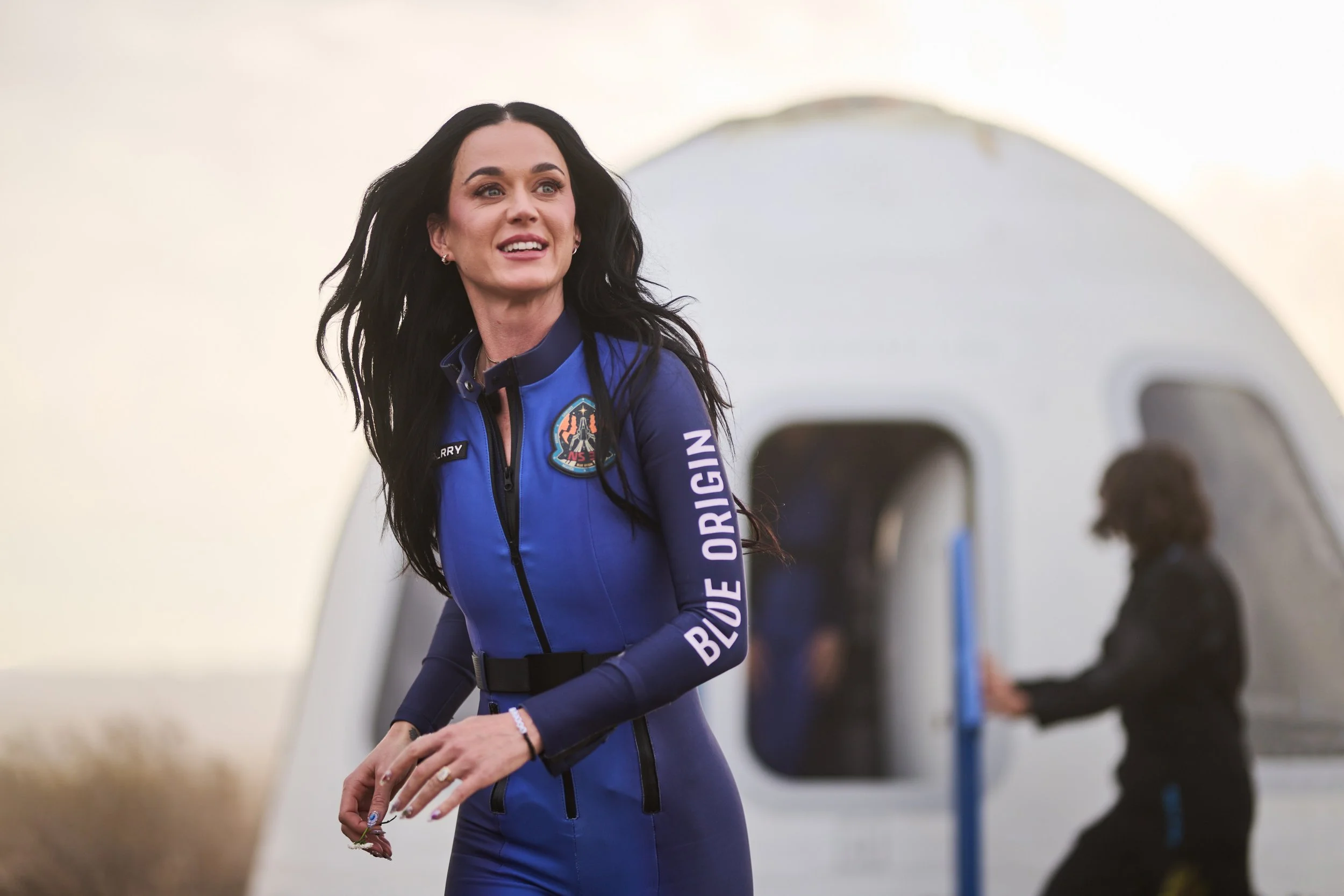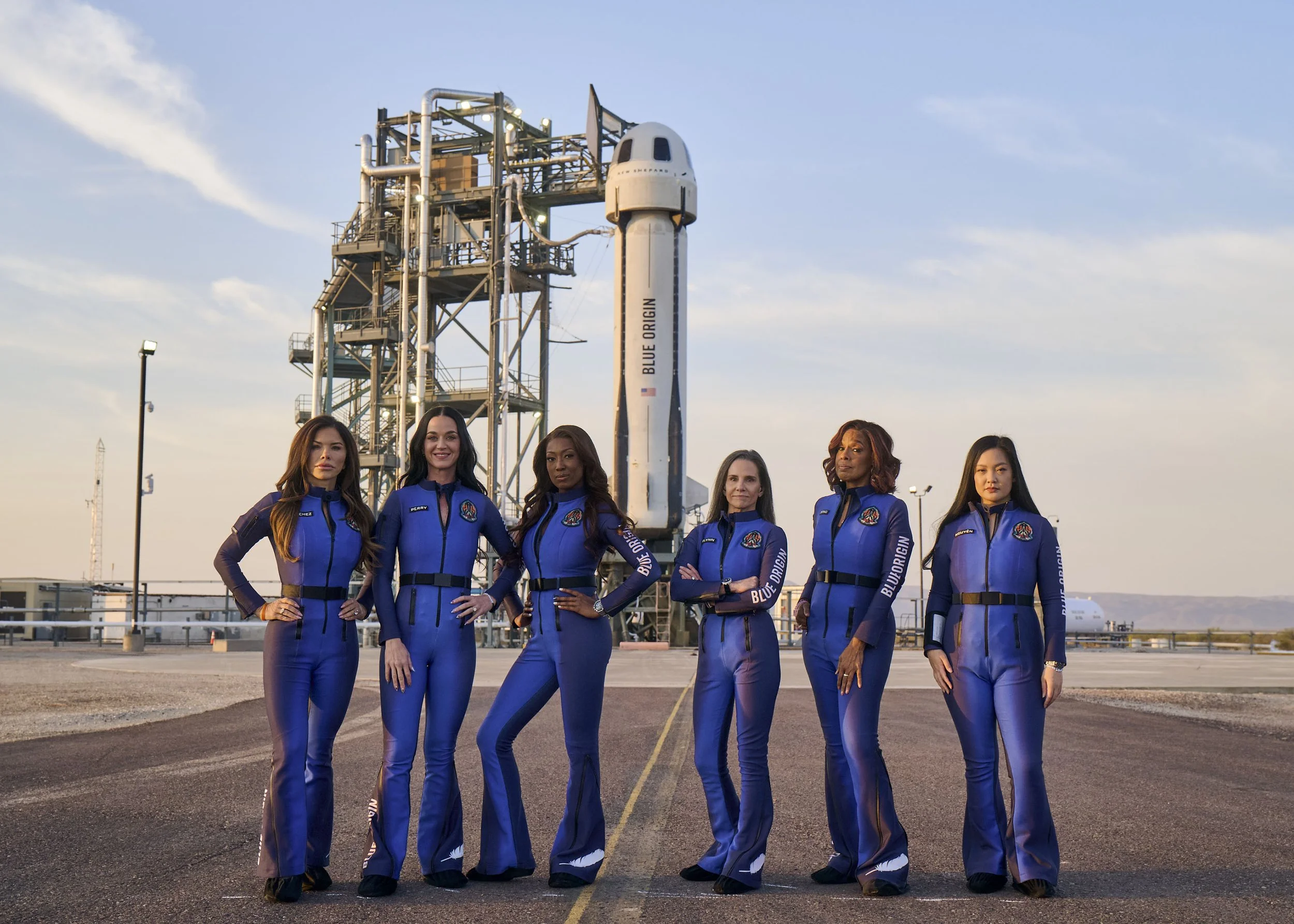Beyond the Kármán Line: Celebrity Spaceflight or Strategic PR Play?
On 14 April 2025, Blue Origin’s New Shepard rocket launched a six-woman crew into suborbital space. Among them were pop star Katy Perry, broadcaster Gayle King, former NASA engineer Aisha Bowe, civil rights activist Amanda Nguyen, producer Kerianne Flynn, and journalist Lauren Sánchez, who also curated the flight and is known publicly as Jeff Bezos’ partner.
Marketed as a milestone, the first all-female spaceflight since Valentina Tereshkova’s solo mission in 1963, the launch was positioned as a celebration of female achievement across disciplines. And on paper, it ticked several boxes. But while some onboard brought real credibility and career milestones, the overall public reaction was far from the empowering, unifying moment Blue Origin seemed to be aiming for.
When symbolism falls flat
Let’s be clear, several women onboard deserved their seats. Amanda Nguyen is a Nobel Prize nominee and advocate for civil rights. Aisha Bowe is a former NASA engineer. These are people whose presence in space sends a strong message about representation and progress.
But the mission was heavily shaped by its more famous faces, Katy Perry, Gayle King, and Sánchez, and the perception that it was more performance than exploration. Cameras were pre-installed inside the capsule, and most of the posing happened only once the crew reached microgravity. That floating period lasts just a couple of minutes, yet much of it was spent striking gestures and showcasing symbolic items they had brought along, including a single white flower.
For something so short, just over ten minutes from launch to landing, those few minutes of weightlessness were a rare opportunity to witness Earth from the edge of space. But instead of taking in that perspective, the moment felt choreographed. For me, it felt like they had planned everything with their teams minute by minute, deciding exactly what to do once they were floating to make sure they got the content they needed for after. They can do what they like, of course, but from a PR perspective it rubbed up against a wider frustration. People dream of that experience, but most will never be able to afford it or be privileged enough to even come close.
And while Katy Perry kissing the ground after landing was probably meant to be a heartfelt preplanned moment, it landed as a meme instead... A pretty funny one though.
Why this flight, why now?
Blue Origin described the flight as a celebration of “female excellence,” curated by Sánchez to bring together women who have made an impact across industries. But NS-31 was also the company’s 31st mission, part of a regular, ticketed suborbital programme. From a PR standpoint, it made sense to wrap this one in a stronger narrative. The all-female framing ensured media attention, a softer public tone, and helped reposition Blue Origin in contrast to the more macho image of private spaceflight.
The company has flown 30 missions so far, 10 of which have carried 52 people to the edge of space. Jeff Bezos himself was on the first crewed flight, NS-16, back in 2021, following 15 earlier test flights. Blue Origin has made it clear their goal is to make space accessible to more people, not just trained astronauts. But right now, it’s only accessible to those with wealth, fame, or the right connections.
There was no stated scientific purpose for NS-31, but plenty of headline-ready sentiment. Katy Perry told USA Today she joined the mission because she wanted to “model courage and worthiness and fearlessness.” She said it was a hard decision as a mum, that she had to “surrender” to the universe, and added, “I feel super connected to love.” She also confirmed she’d “definitely” be writing a song about the experience.
It was hard not to wince. Would a scientist have come down from the edge of space and said they felt connected to love? Or would they have described what they saw, what it meant, and how it tied into decades of work and knowledge? This wasn’t a scientific breakthrough. It was a scripted media loop, complete with ready-made lines for morning TV. It reminded me of influencer evenings, when influencers are invited to a venue before it officially opens or given a ‘special experience’ they barely care about, yet others would dream of. They only care about getting content and feeling important. I’ve had my own guilt in that space. Working with record labels, I’ve been invited to music events and shows I couldn’t care less about, but the free food is fantastic and it’s an easy night out. Then I see posts online from people devastated they didn’t get a ticket, knowing I was there not even recognising half the songs. There’s a strange guilt that comes with it. And this flight felt a bit like that on a massive scale, an incredibly rare opportunity handed to the wrong people, and really rubbed in people’s faces.
And look, if I had the money or relevance, I’d love to go too. I’d be a hypocrite to slag them off for doing it. But from a PR stunt perspective, which this very clearly was, it all landed so flat. The whole thing had the structure of a big cultural moment, but none of the meaning. The campaign tried to position it as empowering and profound, but imagine how different it would have felt if the crew had been six female scientists, using those minutes to reflect on a lifetime of research. That would have been a genuinely beautiful moment. This just wasn’t it.
Did they pay?
Blue Origin hasn’t disclosed who paid for the flight. According to their spokesperson, some crew members paid for their seats while others flew for free. We don’t know whether Katy Perry or the other public figures were paying passengers or not. Blue Origin previously auctioned a seat for $28 million on their first crewed launch, and Virgin Galactic, a competitor, has reportedly charged $450,000 per person for a 90-minute spaceflight.
Roman Chiporukha, co-founder of luxury space travel firm SpaceVIP, said selection isn’t just about money. It’s about “who you are,” your social capital, and whether you align with the launch’s purpose. So while it’s being sold as access for all, in reality it’s still carefully curated.
Is it better than a private jet?
Environmentally, Blue Origin’s New Shepard rocket does have a cleaner emissions profile. It burns liquid hydrogen and oxygen, releasing only water vapour. On paper, that’s better than private jets, which emit around two tonnes of CO₂ per flight hour. So yes, if you’re comparing per-passenger flight time, New Shepard is cleaner.
But that doesn’t mean it’s green. Producing liquid hydrogen is energy-intensive, and the overall footprint of space tourism includes rocket manufacturing, fuelling infrastructure, transport, and upper-atmosphere emissions. The environmental impact becomes more serious when you realise these aren’t one-offs. If commercial space travel scales, the cumulative effects could contribute to long-term atmospheric damage and space congestion.
And yet, despite that, the messaging surrounding the launch leaned heavily into environmentalism. Katy Perry posted about feeling a renewed appreciation for Earth. Gayle King described the view as “life-changing.” The sentiment itself isn’t wrong , seeing Earth from above probably is overwhelming, but in this context it felt jarring. If it was really about protecting Mother Earth, this wasn’t the way to do it. Especially when the entire experience is inaccessible to 99.9 percent of people.
Blue Origin isn’t the only one trying to lead in commercial space. They’ve also just completed the first mission of a new heavy-lift rocket they hope will rival SpaceX’s Starship. Other competitors like Rocket Lab are expected to enter the field soon, with their Neutron rocket possibly launching by the end of 2025. The landscape is becoming less about discovery and more about dominance.
Did it work?
For a moment, yes. The launch dominated headlines and flooded social media. But the cultural afterglow dimmed quickly. The experience didn’t resonate in the way it seemed intended to. It didn’t feel awe-inspiring. It felt strategic.
The only thing most people will remember is the meme of Katy Perry kissing the ground, and not because of what she saw in space, but because of how it looked afterwards. The goal of promoting female empowerment wasn’t a bad one, it was actually a really nice idea. But I genuinely believe they sent the wrong people up. They underestimated how much the public would have got behind a crew of female scientists, astrophysicists, aerospace engineers, planetary geologists, space medicine researchers, finally achieving a life goal that was deeply personal and hard-earned. People love seeing others experience their dreams, especially now, when the news feels relentlessly bleak. This could have been a genuinely uplifting moment to witness, and ironically, it would have done far more for Blue Origin’s PR.
In contrast, SpaceX hasn’t relied on celebrity spaceflights to generate attention. Their missions have focused on scientific achievement, exploration, and building long-term infrastructure. And whether you like Elon Musk or not, that approach has kept SpaceX rooted in purpose. This latest Blue Origin launch almost handed them the upper hand, making SpaceX look serious and focused while Blue Origin looked like it was chasing headlines.
I’d love to see that. A woman who’s studied the universe her entire life, getting to see it from above for the first time. Not a global pop star using her short time floating above Earth to pose for the camera with a flower.
The PR takeaway
This wasn’t about science. It wasn’t really about space. It was about positioning, for Blue Origin, for Bezos, and for the participants. For me, it was a PR stunt, and a smart one on paper. I do think the inclusion of Amanda Nguyen and Aisha Bowe was designed to cover the company’s back a little, and to anchor the experience in something more credible. They genuinely deserved to be there, and I’m happy they got the experience. But let’s not pretend the rest of it wasn’t crafted as a performance.
This could have been powerful. It could have been remembered for the right reasons. Instead, it’s a case study in how quickly even the biggest moments can fall flat when they’re built around aesthetics rather than intention.
Spaceflight doesn’t need celebrities. It needs curiosity. It needs humility. And it only becomes powerful when we stop trying to control how it looks.


